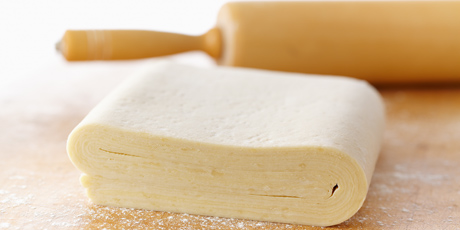
This technique is based on the classic French method of making puff pastry, but is assembled inverted, or “inside out”. Where a traditional puff pastry is made by wrapping a block of butter (beurrage) with a flour/water dough (détrempe) and then folded, this recipe does the reverse and folds the dough with the butter. It is no more challenging a method than the traditional way, but it does result in a remarkably flaky and tender puff pastry that rises evenly and rolls out easily.
Puff pastry does take time to make, as it must rest in between folds, but it is well worth the effort. This recipe makes enough for an assortment of baked items. If just preparing one of these, any excess dough can be frozen for later use. Simply thaw in the fridge before rolling and using.
Makes about 1.4 kg of dough (about 3 lbs)
ingredients
Détrempe
Beurrage
Assembly
directions
For the détrempe step, fit a stand mixer with the dough hook attachment and blend all of the ingredients together on low speed and then , once blended, increase the speed one level and mix for 4 minutes. Shape the dough into an 8-inch square, wrap and chill for at least 30 minutes, up to 2 hours.
For the beurrage, beat the butter with the flour in the stand mixer with the paddle until smooth. Line an 8-inch square pan with plastic and scrape the butter into the pan, spreading to level (as it will be soft). Chill this until it is the same consistency as the détrempe – this could take 30 to 90 minutes. If the beurrage sets firmly or you are making it well ahead, let it soften to just cooler than room temperature.
For the lamination stage, remove the beurrage from the pan onto a well-floured work surface. Dust a heavy rolling pin with flour and roll the beurrage into a rectangle about 16-x-9–inches. Lift the beurrage occasionally to ensure it isn’t sticking to the work surface (after the first roll, it does not stick at all). Place the détrempe in the centre of the beurrage and fold the beurrage over to completely envelope the détrempe. Roll the dough out to a rectangle 20-x-10-inches, flouring the dough and work surface as needed. Fold into thirds, but be sure to dust off any excess flour with a pastry brush before folding. Rotate the dough 90 degrees and repeat rolling the dough to a 20-x-10-inch rectangle, brushing off and folding into thirds. Wrap the dough, label it with a #1 (for first fold) and chill for a minimum of 2 hours up to a day.
For the second fold, roll the dough again into a 20-x-10-inch rectangle, brush off excess flour and fold into thirds. Rotate the dough 90 degrees, repeat the rolling and folding and then wrap and label the dough with a #2 and chill for a minimum of 2 hours and up to a day.
For the final fold, roll and fold the dough the dough into thirds for the final time (just once this time). The dough is now complete, but must be wrapped and chilled for a minimum of 2 hours before using.
The puff pastry dough can keep refrigerated for up to 4 days, or can be portioned and frozen for up to 3 months. Thaw in the fridge before using.
Makes about 1.4 kg of dough (about 3 lbs).
